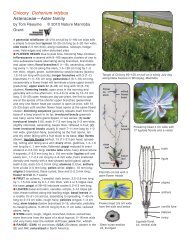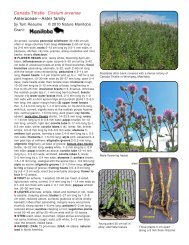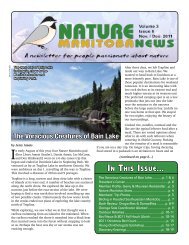View/Download Newsletter (.pdf, 5.21 MB) - Nature Manitoba
View/Download Newsletter (.pdf, 5.21 MB) - Nature Manitoba
View/Download Newsletter (.pdf, 5.21 MB) - Nature Manitoba
Create successful ePaper yourself
Turn your PDF publications into a flip-book with our unique Google optimized e-Paper software.
The Wilderness Committee<br />
An Environmental Catastrophe in the Making:<br />
The Hay Point Bog Peat Mine<br />
United Kingdom, a country which has a centuries-old<br />
tradition of peat mining, and well-established companies<br />
involved in this activity. This year, the UK is closing down<br />
this industry entirely, in spite of the fact that the country is<br />
in dire economic straits and desperately needs the jobs and<br />
income that peat mining provides.<br />
Why are they doing this? Because they<br />
have come to realize that the release of<br />
greenhouse gases through peat mining<br />
nullifies the expensive reductions in<br />
greenhouse gases being made in other areas of the British<br />
economy. Yet <strong>Manitoba</strong>, with its stated objective of respecting<br />
its Kyoto commitments, does the exact reverse. Something<br />
is very wrong with this picture.<br />
Is a park no longer a park?<br />
It boggles the mind that the <strong>Manitoba</strong> government would<br />
even consider allowing such a destructive activity to take<br />
(...continued from page 1)<br />
eat mining is NOT<br />
“P a sustainable or<br />
a renewable industry.”<br />
place within the boundaries of a provincial park. In 2008,<br />
when Premier Gary Doer announced the phase-out of forest<br />
activity in all of <strong>Manitoba</strong>’s parks save one, he summarized<br />
his government’s position with the bold declaration: “a park<br />
is a park is a park.” Yet peat mining is infinitely more<br />
destructive than forestry.<br />
A forestry operation covering a similar<br />
area of the one proposed here would be<br />
over in a matter of weeks and, with<br />
replanting, the regrowth would begin<br />
almost immediately to once again sequester the carbon lost<br />
through clearcutting. On the other hand, peat mining would<br />
take place over 45 years. During this time, the ecological<br />
services provided by the peat bog, including providing<br />
habitat for one of the widest diversities of plant and animal<br />
life in <strong>Manitoba</strong> as well as water filtration services for our<br />
lakes, would come to a complete halt.<br />
(continued on page 11...)<br />
Page 10 <strong>Nature</strong> <strong>Manitoba</strong> News Vol. 4, Issue 2 - Mar. / Apr. 2012





